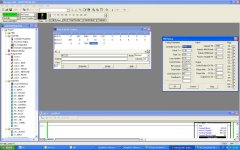Hello there, I'm an engineering student and I'm working on a project for a class about automation.
Scenario: Home automation plc controlling security (eg: fire) and comfort of an public environment. That thing is simulated with a vb program.
I't my first try with plc programming/ladder logic/and PIS's, so be patient plese
Problem: To control temperature in a room I'm using a PLC wich, on a given setpoint (°C scaled on the PID range wich is 0-˜16000), should give a proportional output based on the error. (is it right?)
I've read all the possible literature about PID settings and I was trying to test the PID reaction with a manual input, BUT it doesn't respond to anything i put on it and I'm literally getting mad with that guy.
So I need some hints from people much experienced then me. I'll be alot grateful for any help.

Scenario: Home automation plc controlling security (eg: fire) and comfort of an public environment. That thing is simulated with a vb program.
I't my first try with plc programming/ladder logic/and PIS's, so be patient plese
Problem: To control temperature in a room I'm using a PLC wich, on a given setpoint (°C scaled on the PID range wich is 0-˜16000), should give a proportional output based on the error. (is it right?)
I've read all the possible literature about PID settings and I was trying to test the PID reaction with a manual input, BUT it doesn't respond to anything i put on it and I'm literally getting mad with that guy.
So I need some hints from people much experienced then me. I'll be alot grateful for any help.





